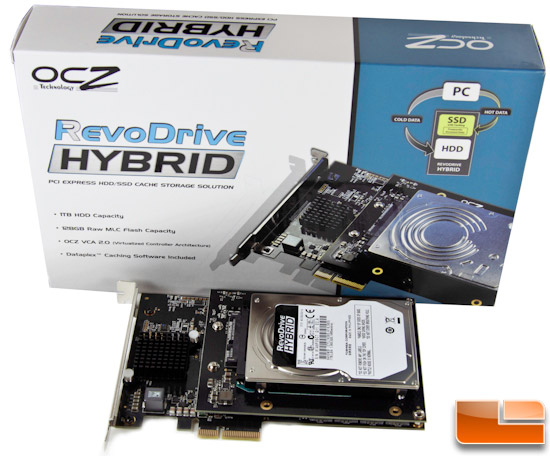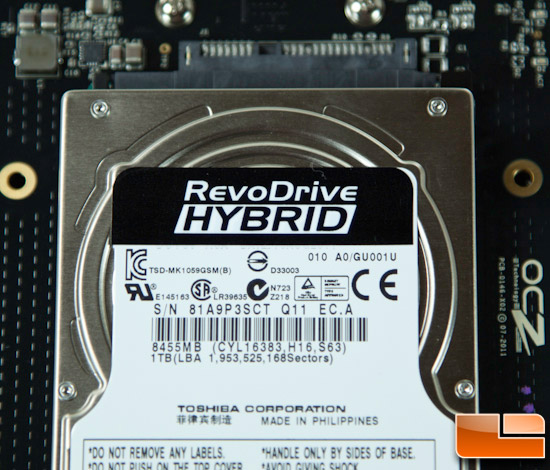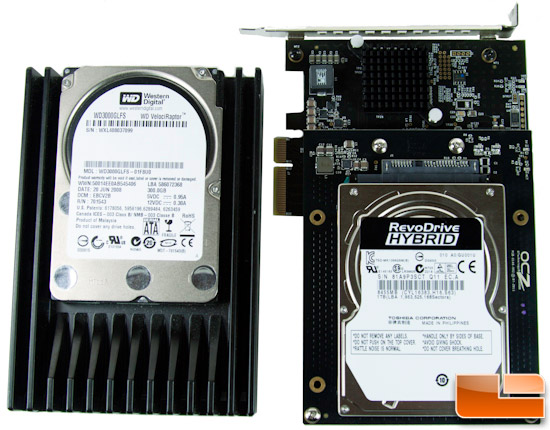OCZ RevoDrive Hybrid 1TB PCI-E SSD Review
Final Thoughts and Conclusions

So, does the RevoDrive Hybrid really provide that speedy SSD feel with gobs of storage for a reasonable cost? The answer is yes – for the most part. Bear in mind that the whole premise behind the drive is to cache the ‘hot’ (most frequently/last used) data onto the SSD to hasten the read/writes. This it does very effectively once the data is identified by the algorithm and cached. Overall, this worked very well and we saw considerable improvements in boot times and data access in our real world tests. These took more than one run to start having an impact and in the case of the boot times, it took several boots to get to the fastest times. Having 100 GB on the SSD portion of the drive is substantial so you can get your cache on with an incredible amount of data. For many users, this could essentially be their entire OS and applications so it should be near top speed most of the time.

That said, file operations could be comparatively sluggish for new files or those that are access infrequently. It may even be extra noticeable when you are used to the sick speeds the SSD portion of the drive can deliver. However, most users that have SSDs today end up storing their media files, etc. on a secondary HDD anyway because of the lack of capacity on their OS SSD. So essentially they are in same boat with the difference being they won’t be getting up to 910MB/s reads and 810MB/s writes off the SSD portion like the RevoDrive Hybrid users. With just a few days to play around with the drive outside of benchmarks, we really didn’t feel a distinct difference when accessing various data off the drive to the point where could identify when it was being pulled from the HDD versus the SSD. The system feels snappy and responsive which means the algorithm that determines hot/cold data is doing a decent job although a more long term and in depth use would certainly give us a better feel for its effectiveness.

There are potential downsides we’ll point out in no particular order. First, depending on the board you are using, the RevoDrive Hybrid may hog up two expansion slots in your system. For small form factor systems, this could be a deal breaker but for many, this won’t be an issue. Don’t even think about using one in a laptop for obvious reasons. Secondly, were are dealing with a RAID array here. Although OCZ has informed us that the data on the cache drive is mirrored from the HDD, whenever you are dealing with multiple drives, your risk of unpleasant things happening increases. Of course, OCZ does back it with a 3 year warranty and toll free customer support. Third, not a huge deal but if you plan on migrating from an existing system via an image/backup, bear in mind that the device driver must be installed for the OS to properly recognize the drive. So make sure it’s installed BEFORE making your final image/backup or you’ll be wasting a lot of time. We installed a fresh copy of Windows so didn’t test this scenario out but have done so before on earlier RevoDrives. Lastly, our friend TRIM is not going to work with Windows 7 at this time although the Virtualized Controller Architecture 2.0 does support it. Windows 7 simply won’t pass the command and this is up to Microsoft to address so don’t bother lobbying OCZ to fix it. With the SSD portion being the cache drive and outfitted with plenty of overprovisioned NAND, this shouldn’t be a major concern – especially when it’s rocking two SF-2281 controllers which we know do an excellent job of drive maintenance with wear-leveling and garbage collection.
The Hybrid’s closest competitor is Intel’s SRT which doesn’t really give as good overall performance from what we’ve seen and most of the major downsides we’ve just pointed out apply in addition to having to buy a supporting motherboard. It’s a little more flexible though and can certainly be an attractive option. The Seagate Momentus XT is a consideration as well but its 3Gbps interface will really hold it back from competing effectively with the RevoDrive Hybrid.

Finally, we look at the overall value. The 1TB RevoDrive Hybrid with the 100 GB SSD cache is selling for $475.00 so the value is in the eye of the beholder. If you were to buy a RevoDrive and 1TB HDD separately, you’d pay roughly the same amount. However, you can pick up a SATA III 120 GB SSD pretty easily these days for around $200 and a 1TB HDD for $60. That’s a significant cost savings for manually deciding which data you want on the SSD versus HDD. If you already own a Z68 board or need to upgrade your board anyway, you can use the separate SSD/HDD configuration and relinquish the decision making to the Intel SRT hardware. Both of these options will give you less raw horsepower in terms of SSD bandwidth but I doubt you’d notice the difference. So given the above, the RevoDrive Hybrid may not be the best deal. This isn’t a knock OCZ’s pricing as we actually think it’s priced fairly. However, there are a lot of users that currently do not have Z68 boards or even boards with SATA III ports. Those users would probably see a lot more value in the RevoDrive Hybrid because they’ll get nowhere near the performance with a single SSD OS drive and an HDD data drive. It’s definitely worthy of consideration.
We like that OCZ is continually making strides to be creative in the SSD space and the RevoDrive Hybrid is just another example of them going where others don’t even dare to venture. For that, they have proudly earned the Legit Review Innovation Award!

Legit Bottom Line: OCZ’s RevoDrive Hybrid, their latest twist on the PCI-E SSD genre, is something that users without SATA III supporting hardware may give serious consideration to, but those that have more modern boards have more compelling options to choose from.

Comments are closed.